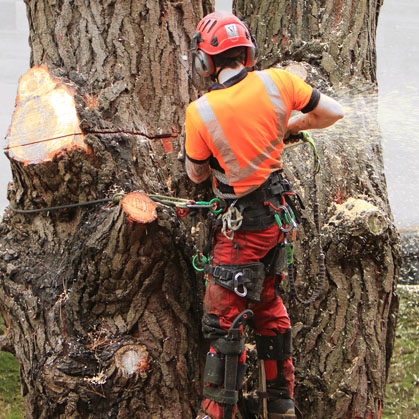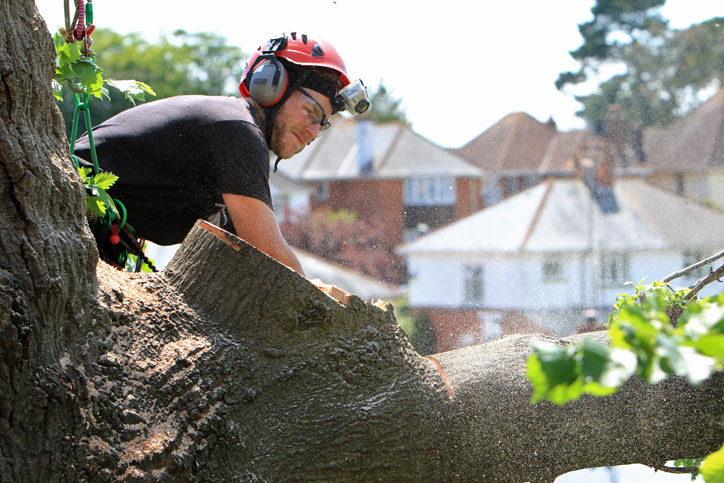
Understanding Arboriculture: Tree Removal
Trees can easily become damaged in a storm or become infected with parasites or pathogens. It’s always recommended to call an expert to assess the health of any tree that is causing concern, before it becomes unstable and dangerous. In the worst case scenario the tree may have to be felled. This is a last option for an arborist and is usually driven by the safety of the tree and the general public, as well as any property beneath the tree.
In this article I want to look at the situations where tree removal is necessary and where the law stands on cutting down trees.
Diseased Trees
A tree can live for many years with ailments that gradually claim parts of it; the process being kept in check by removing the dead or diseased portions. However continuing to do this can be expensive, and eventually so much of the tree may be removed that it is no longer viable. Before it becomes dangerous, it may be necessary to have it removed.
Many tree diseases can be easily transferred and tree felling is one way of trying to contain tree diseases like ash dieback or phoney peach disease before they get out of control.
Damaged and Dangerous Trees
Storms and especially lightning can wreak havoc on a tree. A tree that is split down the middle or has large branches hanging from it requires expert attention. Trees can also be damaged by herbicides, although they may recover. If a tree displays evidence of serious trunk damage, for example if the trunk is cracked, displays seams or dead stubs, these are warning signs that all is not well. Old, deep wounds could suggest extensive internal decay meaning the tree should be removed. Where more than 25 per cent of the trunk has been compromised, the tree may not strong enough to keep growing safely.
Crossed or rubbing branches should be dealt with as they are a danger and an area of potential weakness. Narrow branch angles can lead to splitting and preventative measures, such as Cobra Bracing, may be required. A tree surgeon can evaluate these issues and determine whether they can be corrected using specialist arborist equipment or if the tree needs to be removed.

Unstable Tree Growth
A dying tree that is not in danger of damaging on anyone or anything can probably be left to die in peace. Dead trees can be havens for wildlife. If however it is posing a risk to people or property then rapid action is recommended! Professional advice is always necessary in weighing up the pros and cons of whether to remove a tree that is potentially becoming unstable. Arborists will consider the species of the tree, its general health, whether the trunk is damaged and if any part of the tree is hollow. When the tree is hollow, the xylem and phloem may still function, but trunk strength may be compromised.
Large dead branches could be dangerous, and if most of its dead branches are on one side, the tree could be a lopsided hazard. Sprouts or small branches from the trunk could indicate that the tree is very stressed.
If the tree is leaning, has damaged roots, is under power lines or has very little space it may need to be removed.
Felling trees is inherently dangerous and definitely a job for a trained and qualified professional.
Tree Felling and the Law
Before undertaking any significant work on a tree, it is wise to establish if the tree is covered by a Tree Protection Order (TPO). TPOs are administered by Local Planning Authorities (LPA), and are made to protect trees that make a significant contribution to the local area. To carry out tree works requires an application to the appropriate LPA. An arborist can provide advice when making an application to fell a protected tree.
If a tree does not have a TPO but is in a conservation area, the LPA must receive notice of any works at least six weeks prior so that it can consider giving the tree a TPO. For trees less than 1.5 metres in height or 7.5 centimetres in diameter, this is not necessary.
The Forestry Commission is responsible for the protection of forests in Great Britain, which includes issuing licences for felling trees. Prosecution can result from felling trees without a licence. The landowner can apply for the licence, or you may do so if you are a tenant of the property and the terms of your lease entitle you to fell trees. If in doubt, it is best to check with your local Forestry Commission office. Forms are also available online from the Forestry Commission website at http://www.forestry.gov.uk/felling. In ordinary private gardens, a licence to fell trees is generally not required.
Always seek the expertise of a professional arborist or tree surgeon if you’re worried about a diseased, damaged or unstable tree.
